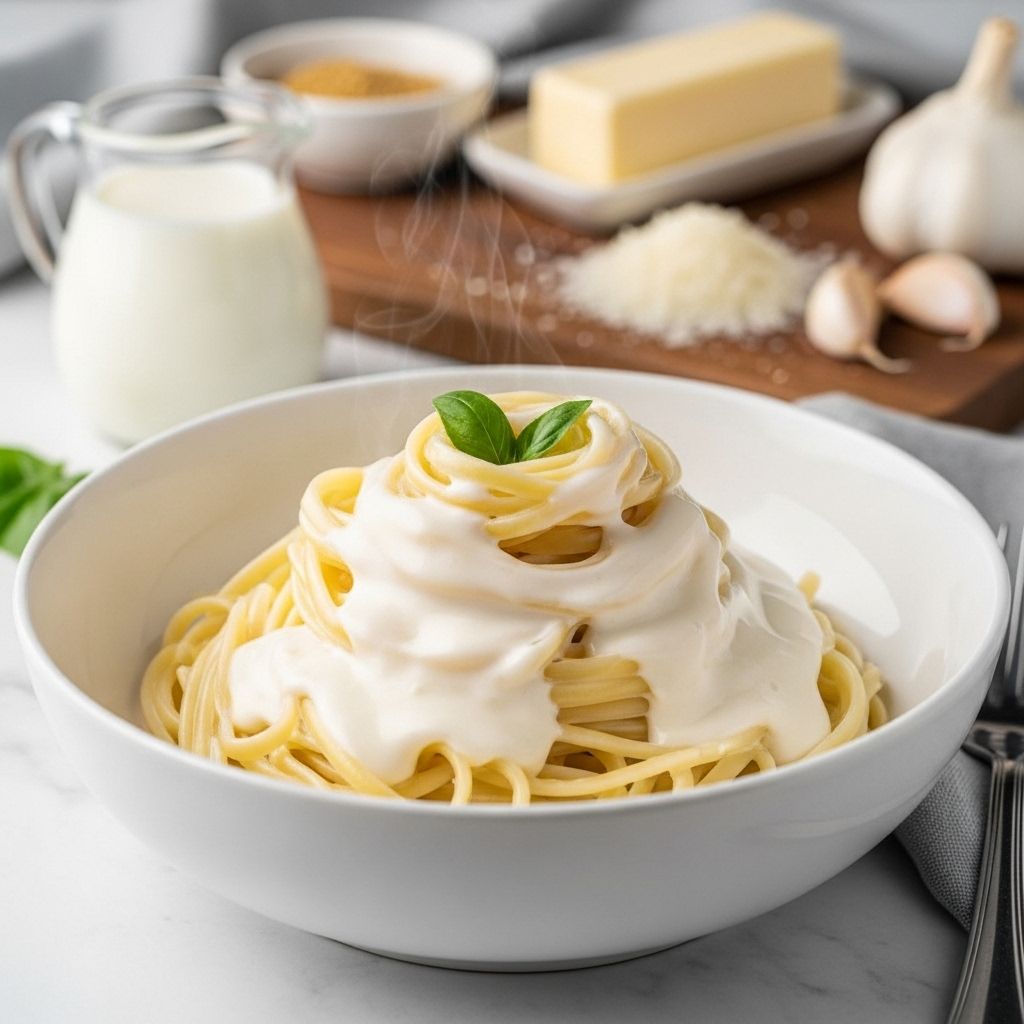Classic White Sauce for Pasta: Creamy Perfection for Every Dish
Master a silky, lump-free base that enhances casseroles, gratins, and comforting classics.

Image: HearthJunction Design Team
White Sauce for Pasta: A Timeless Kitchen Staple
This classic white sauce for pasta—often called béchamel—remains a cornerstone of countless pasta recipes and comfort dishes. With a creamy, subtly rich flavor and a texture that clings perfectly to noodles, this sauce is beloved for its simplicity, versatility, and foolproof results. Whether you’re a beginner or an experienced cook, mastering this sauce opens up a world of culinary possibilities, from macaroni and cheese to lasagna and beyond.
Table of Contents
- What Is White Sauce?
- Essential Ingredients
- Step-by-Step Preparation Guide
- Tips, Tricks, and Variations
- Creative Uses for White Sauce
- Storing and Freezing White Sauce
- Nutrition Insights
- Frequently Asked Questions (FAQ)
What Is White Sauce?
White sauce, or béchamel, is one of the classic French “mother sauces”—a foundational recipe from which many others are derived. It starts with a roux (a cooked mixture of flour and butter) to which milk is gradually added, creating a smooth, creamy sauce that acts as a perfect blank canvas for countless dishes. The flavor is mild and buttery, making it incredibly adaptable: you can keep it plain, or build on it with cheese, cream, herbs, or aromatics to suit any cuisine or personal taste.
Essential Ingredients
The beauty of white sauce lies in its simplicity. You’ll need just a few pantry staples:
- Butter: Adds richness and helps form the base of the roux.
- All-purpose flour: Thickens the sauce.
- Milk: Whole milk is preferred for its creaminess, but 2% or non-dairy alternatives can also work.
- Salt & pepper: Essential for flavor balance.
- Optional additions: Nutmeg, garlic, cheese, or cream can be added to customize the sauce for different recipes.
| Ingredient | Amount | Role |
|---|---|---|
| Butter | 2 tablespoons | Forms roux, adds flavor |
| All-purpose flour | 2 tablespoons | Thickens sauce |
| Milk | 1 cup | Creates creamy base |
| Salt | To taste | Seasoning |
| Pepper (optional) | To taste | Flavor enhancer |
| Nutmeg (optional) | Pinch | Classic aromatic touch |
Step-by-Step Preparation Guide
Making this versatile sauce takes just a few steps. Here’s how to ensure creamy, lump-free results every time:
- Make the Roux
Melt the butter in a medium saucepan over medium-low heat. When melted and bubbling, add the flour. Whisk constantly for 1–2 minutes, until the mixture forms a smooth paste and turns slightly golden (do not let it brown). - Add the Milk
Gradually pour in the milk, whisking continuously. This slow addition ensures the sauce stays lump-free. Continue whisking until the mixture is smooth. - Cook Until Thickened
Bring to a gentle simmer, still whisking. The sauce will begin to thicken in 3–5 minutes. If using, add a pinch of nutmeg, and season with salt and pepper to taste. - Taste and Adjust
Once thickened to your liking (it should coat the back of a spoon), remove from heat. Add cheese or herbs, if desired, and whisk until fully incorporated.
Pro Tips for Perfect White Sauce
- Use a balloon whisk to ensure lump-free texture.
- Don’t rush the roux—cooking it gently prevents a raw flour taste.
- For a silkier sauce, warm the milk before adding it to the roux.
- If the sauce turns too thick, whisk in a splash of milk to loosen it up.
Tips, Tricks, and Variations
Mix up your white sauce with creative twists and practical advice:
- Cheese Sauce: Add 1/2 cup grated Parmesan, Gruyère, or cheddar to transform it into a cheese sauce—perfect for macaroni and cheese or lasagna.
- Mornay Sauce: Combine white sauce with Gruyère and Parmesan for this classic French cheese sauce.
- Cream Sauce: Substitute part or all of the milk with heavy cream for added richness.
- Soubise: Stir in puréed cooked onions for a subtly sweet flavor.
- Herb or Garlic Sauce: Add minced garlic to the roux, or finish the sauce with fresh herbs like parsley or basil.
- Non-Dairy Adaptation: Use plant-based milks (such as oat or almond) and vegan butter for a dairy-free version that still offers wonderful creaminess.
Creative Uses for White Sauce
This sauce’s versatility makes it a must-have in any cook’s repertoire. Popular uses include:
- Macaroni and Cheese: Mix with pasta and grated cheese, then bake for a comforting classic.
- Lasagna: Use as the creamy layer in traditional or vegetarian lasagna.
- Chicken, Turkey, or Vegetable Pot Pie: Stir into cooked fillings before baking for luxurious comfort food.
- Eggs Florentine: Spoon over poached eggs and spinach on toasted English muffins.
- Gratin Dishes: Pour over potatoes or cauliflower before topping with breadcrumbs and baking.
- Country Gravy: Add cooked sausage or bacon, then serve over biscuits for a hearty breakfast.
- Seafood Pasta: Stir in shrimp, scallops, or crab for a restaurant-quality meal.
Storing and Freezing White Sauce
Advance preparation makes weeknight dinners a breeze:
- Refrigerate: Store cooled white sauce in an airtight container in the refrigerator for up to 5 days.
- Reheat Gently: Warm over low heat, adding a little milk as needed to restore creaminess.
- Freeze: White sauce also freezes well. Cool completely, transfer to freezer-safe containers, and freeze for up to 3 months. Thaw overnight in the refrigerator before reheating and whisking smooth.
Nutrition Insights
| Nutrient | Per Serving | Daily Value |
|---|---|---|
| Calories | Approximately 90 | 4.5% |
| Total Fat | 7g | 9% |
| Saturated Fat | 4g | 20% |
| Carbohydrates | 5g | 2% |
| Protein | 2g | 4% |
| Sodium | 80mg | 3% |
Nutrition values will vary depending on milk and added ingredients.
Frequently Asked Questions (FAQ)
Q: Can I make white sauce ahead of time?
A: Yes, white sauce can be made in advance. Refrigerate for up to 5 days or freeze for up to 3 months. Reheat gently, adding more milk if necessary to reach your desired consistency.
Q: How do I fix lumpy sauce?
A: Whisk the sauce vigorously to break up lumps. If lumps persist, strain the sauce through a fine-mesh sieve. Prevent future lumps by adding milk gradually and whisking continuously.
Q: Can I add cheese directly to the sauce base?
A: Absolutely. Once your white sauce is thickened, remove it from heat, then whisk in grated cheese a handful at a time until melted and smooth for a classic cheese sauce.
Q: Is it possible to reduce the fat in this recipe?
A: For a lighter version, use low-fat milk or plant-based alternatives. You can also substitute part of the butter with olive oil, but note that sauce will be slightly less rich.
Q: What herbs and spices work well in white sauce?
A: Nutmeg is classic, but white pepper, fresh thyme, parsley, chives, or a hint of garlic all complement the sauce beautifully.
Conclusion
Whether you’re building a classic pasta dish, layering a spectacular lasagna, or simply looking for a comforting and quick weeknight sauce, mastering this white sauce for pasta delivers endless possibilities. With a few basic ingredients and straightforward steps, you can elevate your home-cooked meals and delight family or guests with restaurant-quality results every time.
Try These White Sauce Variations Next
- Alfredo Sauce: Add cream, Parmesan, and a hint of garlic for a richer, more decadent taste.
- Creamy Garlic Pasta: Blend in sautéed garlic and finish with chopped parsley for an aromatic, savory option.
- Herbed Cheese Sauce: Stir in mixed cheeses and fresh herbs for an extra flavor punch.
Ready to create your own signature dish? Start with this classic white sauce, and let your culinary creativity take over!
References
- https://www.allrecipes.com/recipe/21171/white-sauce/
- https://www.allrecipes.com/recipe/19402/quick-and-easy-alfredo-sauce/
- https://www.allrecipes.com/recipe/269500/creamy-garlic-pasta/
- https://www.allrecipes.com/recipe/277256/easy-homemade-alfredo-sauce/
- https://www.allrecipes.com/recipe/11945/easy-alfredo-sauce-i/
Read full bio of Shinta












